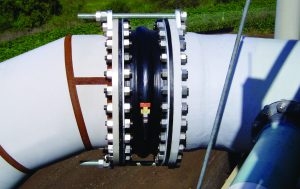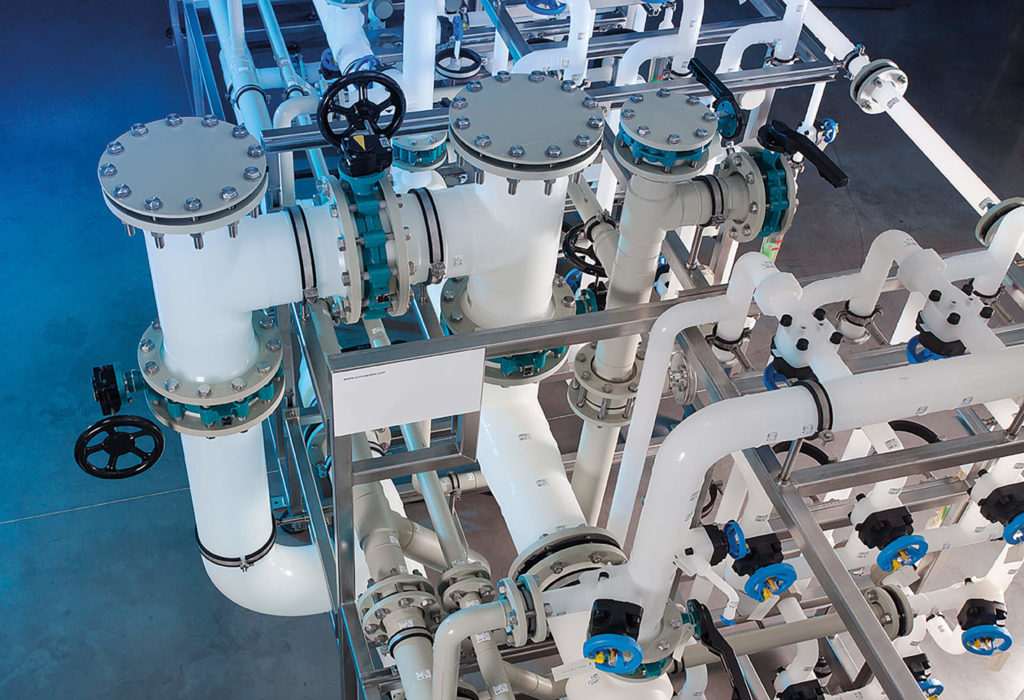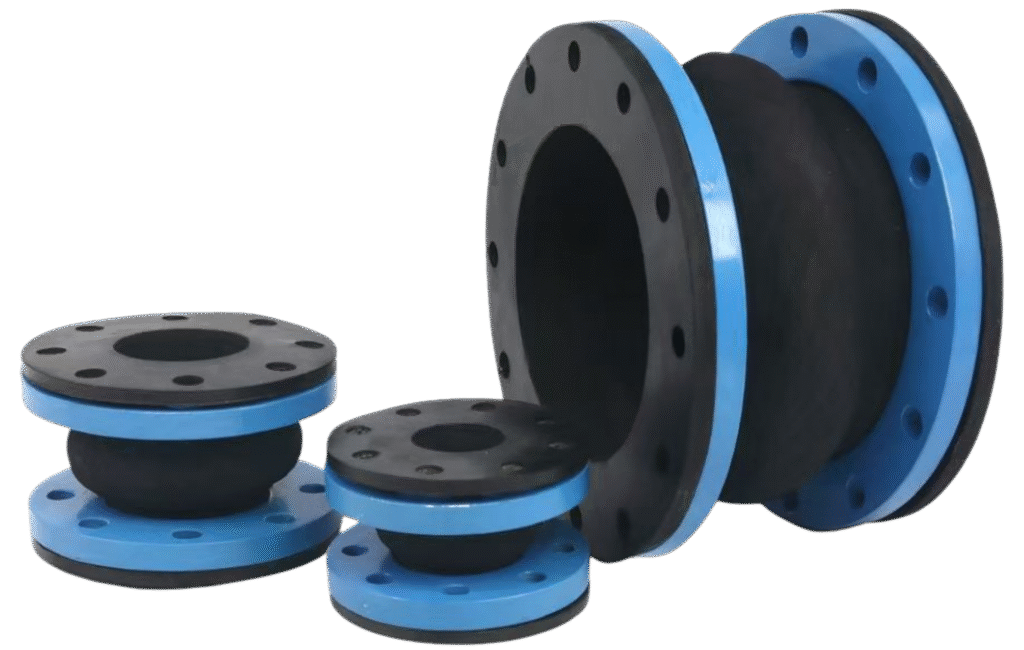What types of expansion joints are suitable for chemical and petrochemical plants?
In chemical and petrochemical industries, selecting the right expansion joint is critical due to the high temperatures, high pressures, and various corrosive media involved. Suitable expansion joints not only effectively absorb pipeline displacement caused by thermal expansion and contraction but also prevent chemical leaks, ensuring production safety. Common types include rubber expansion joints, PTFE-lined expansion joints, and metal expansion joints. Rubber joints typically use materials like EPDM, NBR, or fluororubber, which offer good corrosion resistance and elasticity, suitable for moderate temperatures and various chemical media. PTFE-lined joints are especially suited for strong acid and alkali environments, providing excellent resistance to extreme corrosion. Metal expansion joints, known for their high-temperature and high-pressure tolerance, are widely used in steam and exhaust systems. Additionally, fabric expansion joints are used in high-temperature flue gas systems, offering flexibility and heat resistance for special applications. Selection should be based on the pipeline’s medium, temperature, pressure, and displacement requirements to ensure the expansion joint’s service life and system safety.



What types of expansion joints are suitable for chemical and petrochemical plants?
Rubber expansion joints: Made from EPDM, NBR, or fluororubber, suitable for moderate temperatures and corrosive media, offering good flexibility.
PTFE-lined expansion joints: Ideal for highly corrosive fluids, with excellent acid and alkali resistance.
Metal expansion joints: Made from stainless steel or alloy bellows, capable of handling high temperature and pressure, but may require special coatings for corrosion protection.
Fabric expansion joints: Constructed from high-performance fabrics like fiberglass or aramid, suitable for high-temperature flue gas or duct systems.
Selection should be based on the medium, temperature, pressure, and movement requirements to ensure safety, durability, and system efficiency.
What type of expansion joint is best for highly corrosive chemical pipelines?
In highly corrosive environments like chemical or petrochemical plants, PTFE-lined rubber expansion joints are the preferred choice. PTFE (Polytetrafluoroethylene) has excellent resistance to almost all aggressive media, including concentrated acids, alkalis, chlorine gas, and organic solvents. When bonded to EPDM or Viton outer layers, it combines chemical resistance, flexibility, and pressure tolerance. This type of joint is especially useful in sulfuric acid lines, chlor-alkali systems, and other pipelines transporting hazardous fluids. Compared to metal bellows, non-metallic PTFE-lined joints offer better corrosion protection, lower maintenance needs, and quieter operation.
✅ Why it matters: Preventing internal corrosion extends service life, reduces downtime, and improves plant safety compliance.
Why is gas-tight sealing critical in petrochemical expansion joints?
Gas-tight sealing is essential in petrochemical applications where pipelines may carry volatile, toxic, or explosive gases. A tiny leak at the expansion joint could cause fire hazards, VOC emissions, equipment damage, or regulatory violations. Non-metallic expansion joints designed for such environments often include multi-layer sealing membranes, gas barriers (like fluoroplastics), and reinforced flanges to ensure leak-free operation. In addition, flexible joints must maintain their seal even under constant vibration and thermal cycling, which is common in refineries and chemical reactors.
✅ Key benefit: Using the correct sealing structure not only protects the plant but also ensures environmental and safety compliance in critical processes.
What are the main functions of expansion joints?
Expansion joints are primarily used to absorb axial, lateral, and angular movements caused by temperature changes, pressure fluctuations, or equipment vibrations, preventing stress concentration and damage to the pipeline. Additionally, expansion joints help reduce vibration and noise, protect the safe operation of pipelines and equipment, and extend the system’s service life. Proper design and installation of expansion joints are key to ensuring stable and efficient operation of the entire piping system.
How to ensure the service life of expansion joints?
The service life of expansion joints depends on correct material selection, scientific design, and proper installation. First, select suitable materials based on the medium’s temperature, pressure, and corrosiveness. Second, the expansion joint should meet the designed movement and stress requirements to avoid excessive stretching or compression. During installation, avoid mechanical twisting, lateral displacement, and excessive vibration. Regular inspection and maintenance can also help identify potential issues early, ensuring long-term stable performance of the expansion joints.
Why is the sealing performance of expansion joints so important in chemical plants?
The sealing performance of expansion joints in chemical plants is a critical factor for ensuring production safety and environmental protection. Since pipelines often transport toxic, flammable, and highly corrosive chemicals, poor sealing can easily lead to leaks, posing serious safety risks. Leaks not only endanger workers’ health but may also cause fires or explosions, resulting in environmental pollution and heavy fines. Additionally, good sealing maintains stable pipeline pressure, prevents process interruptions, and ensures product quality. On the other hand, poor sealing accelerates pipe wear and corrosion, shortens equipment lifespan, and increases maintenance frequency and costs. Therefore, selecting high-quality sealing materials fully compatible with the transported media and ensuring proper installation are fundamental to safe operation and economic efficiency in chemical plants.
What risks does using the wrong expansion joint pose to a chemical plant?
Using the wrong expansion joint in a chemical plant can lead to a series of serious problems that directly affect production safety and economic efficiency. Firstly, if the expansion joint material cannot withstand the chemical media inside the pipeline, the sealing layer may quickly corrode or rupture, causing leaks of toxic or flammable substances, which seriously endanger employee safety and environmental health. Secondly, expansion joints that do not meet temperature or pressure requirements are prone to hardening, cracking, or bursting, resulting in pipeline system failure. Thirdly, expansion joints unsuitable for dynamic loads cannot effectively absorb equipment vibrations and thermal expansion or contraction, exacerbating pipeline fatigue damage and weld cracking. Additionally, these failures often cause unexpected shutdowns, leading to production interruptions and costly repairs. Furthermore, if the expansion joint’s design or material does not comply with safety regulations, the company faces compliance risks, including regulatory penalties or certification failures. Therefore, choosing expansion joints specifically customized for chemical environments is crucial to ensuring plant safety and improving operational efficiency.


